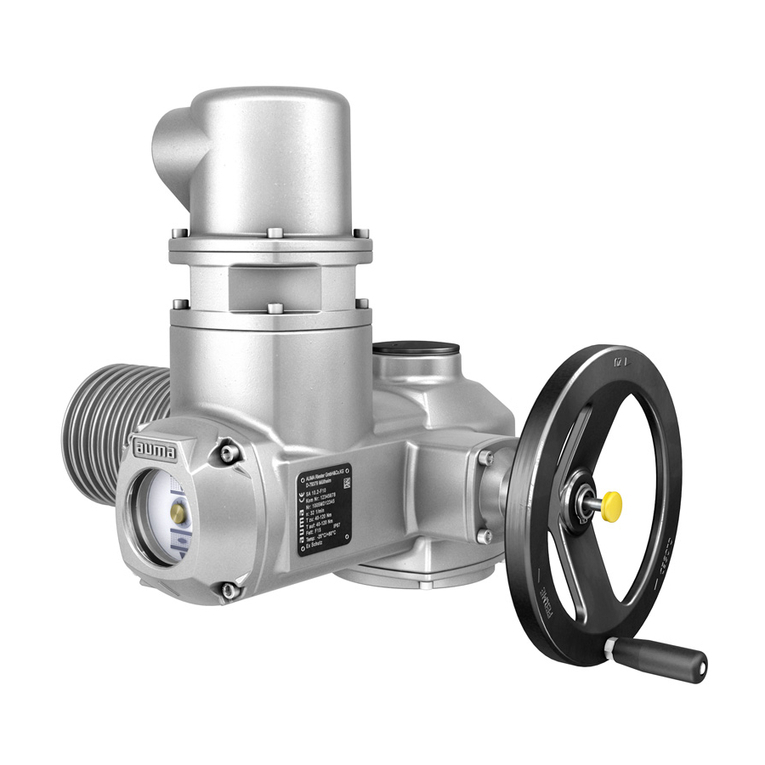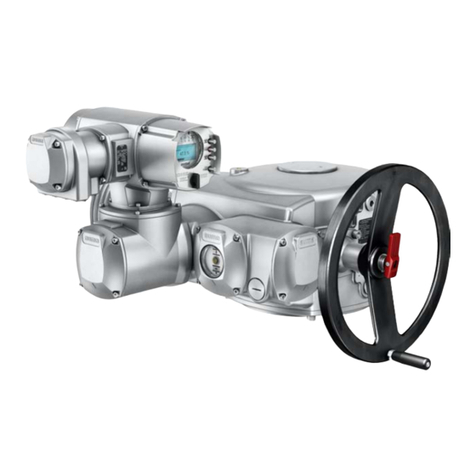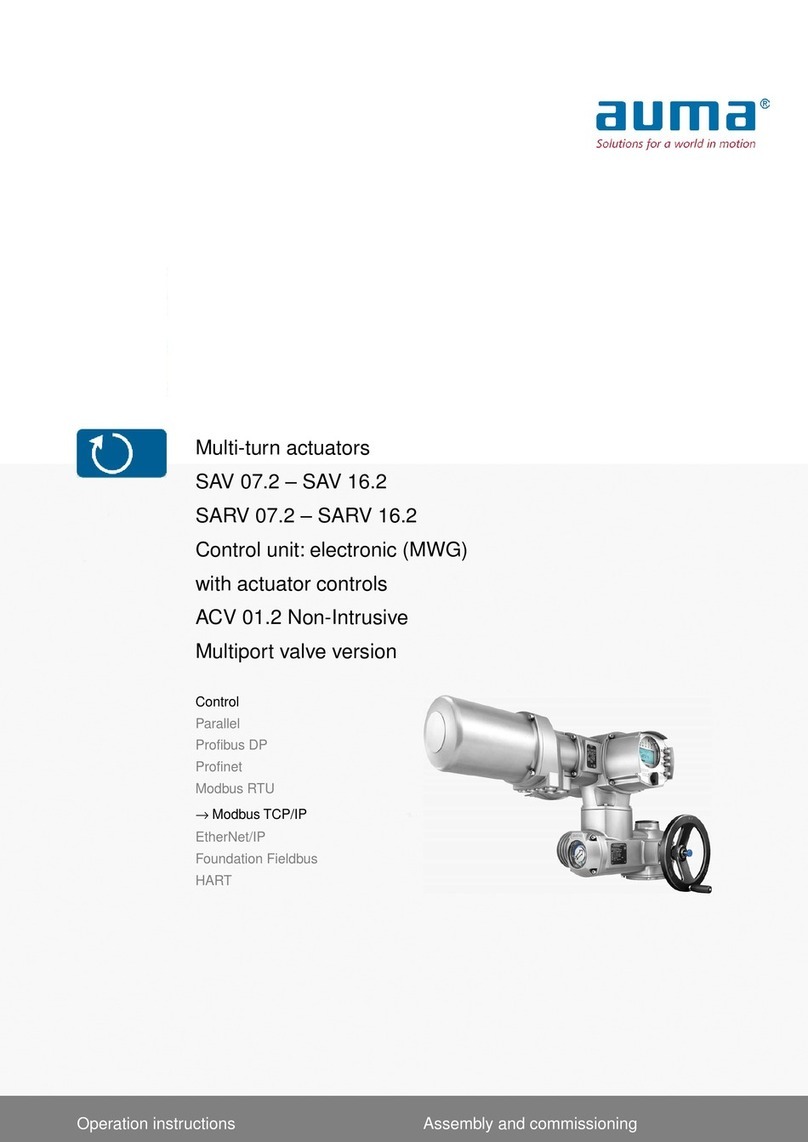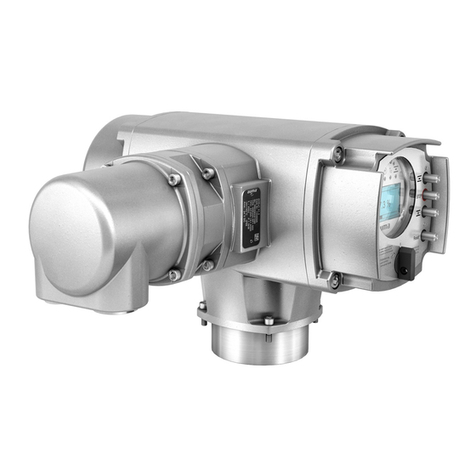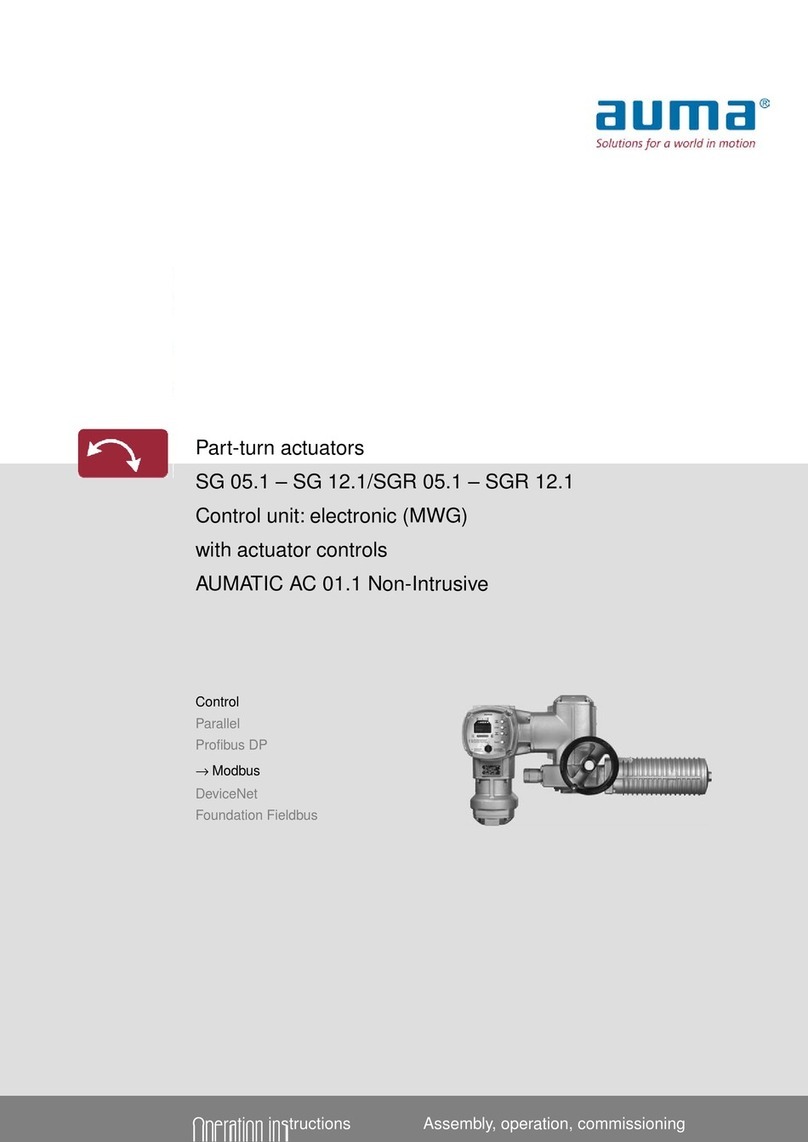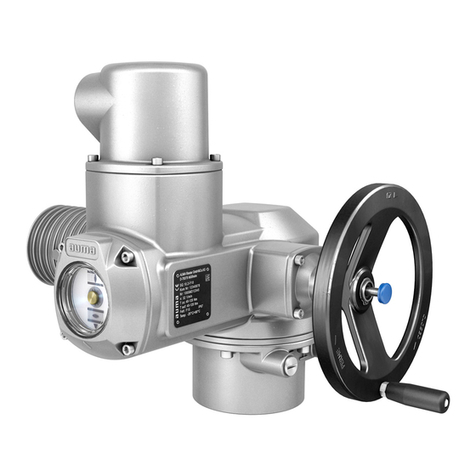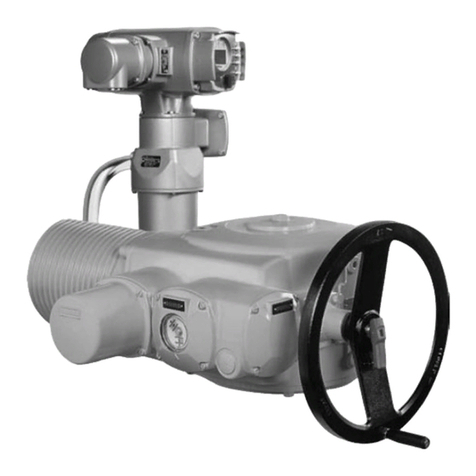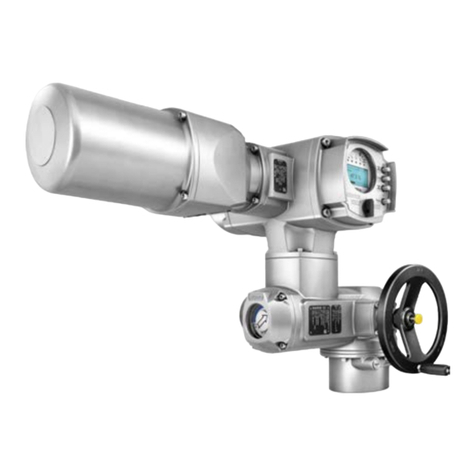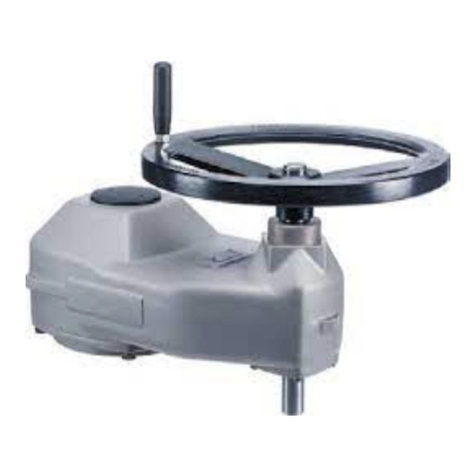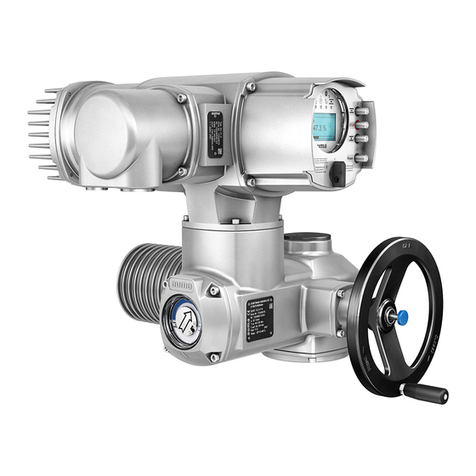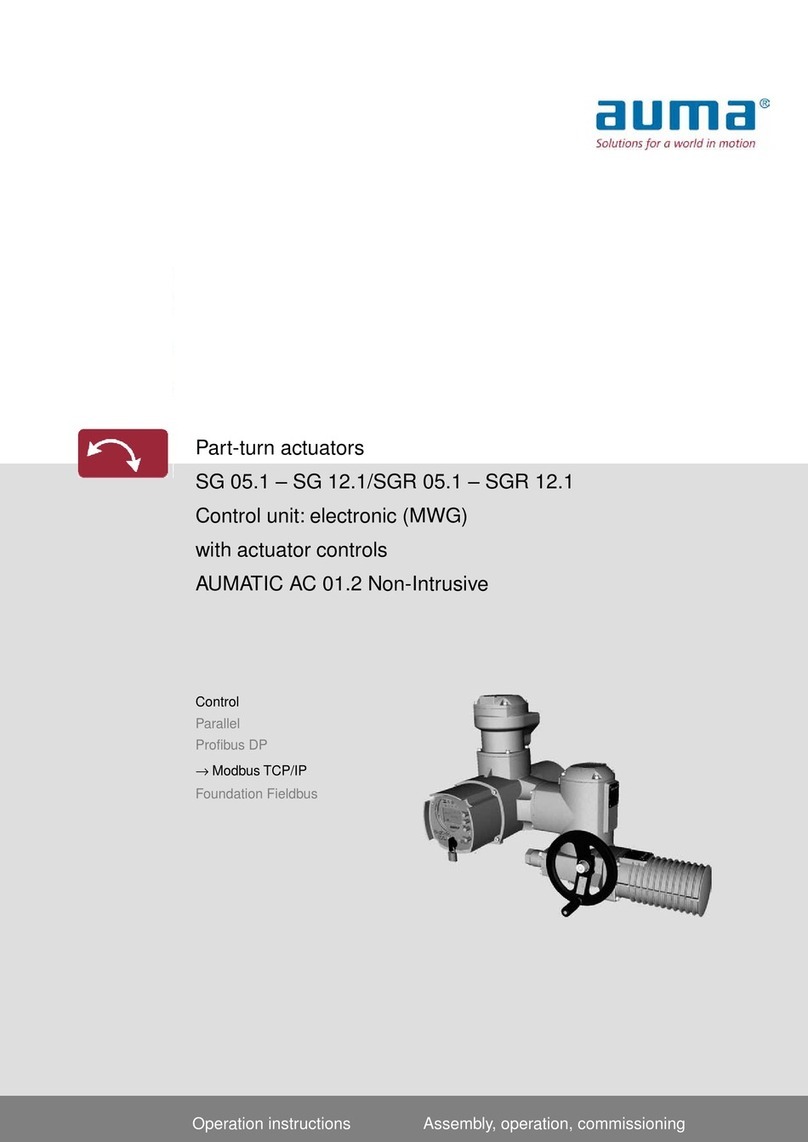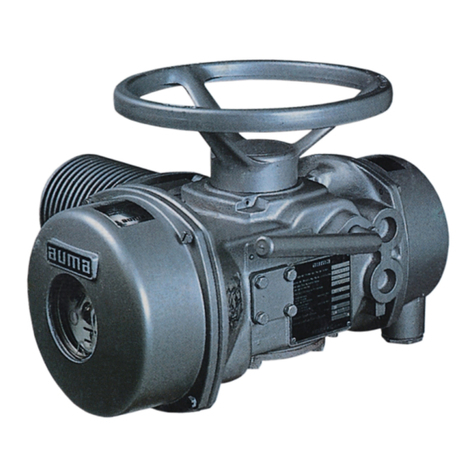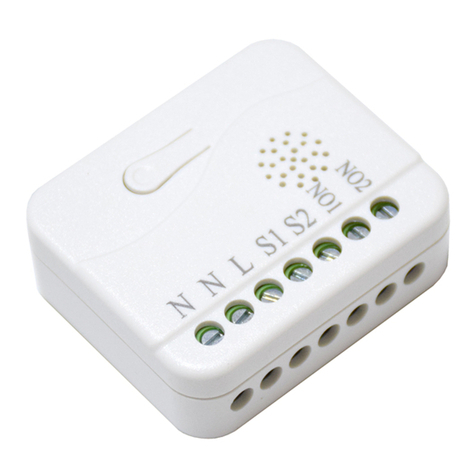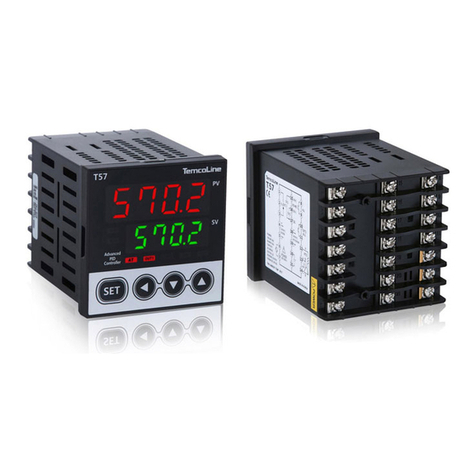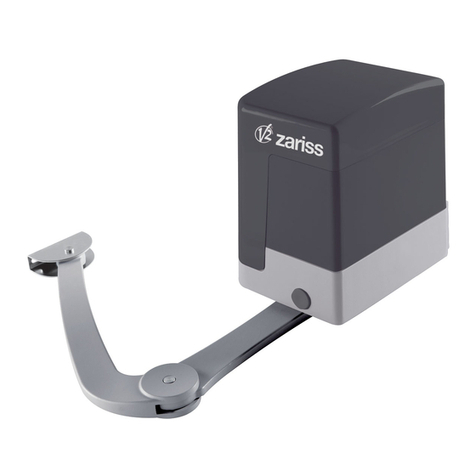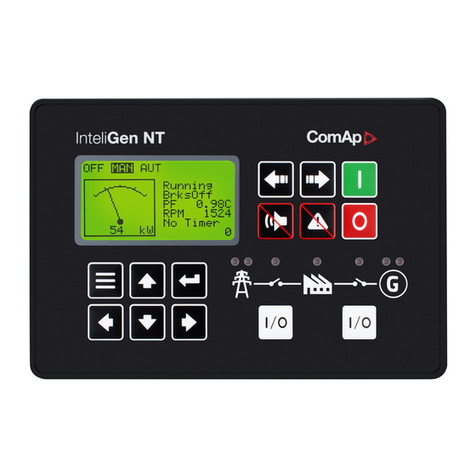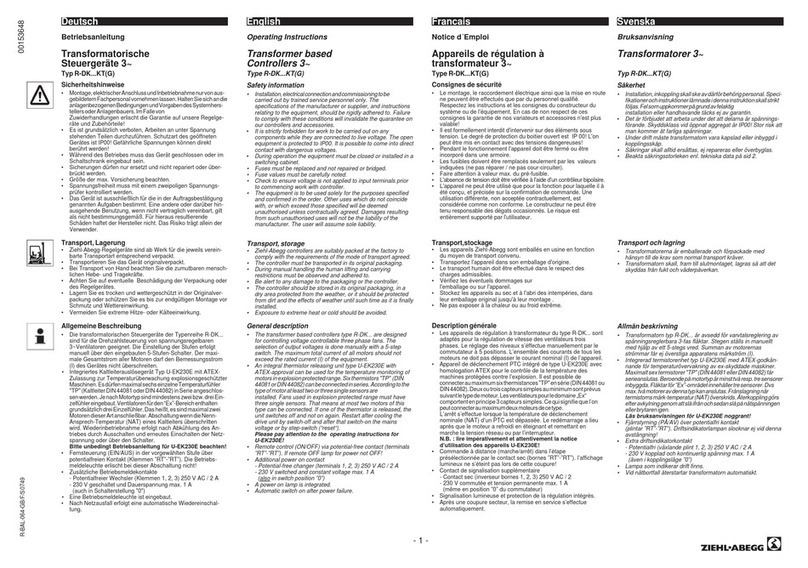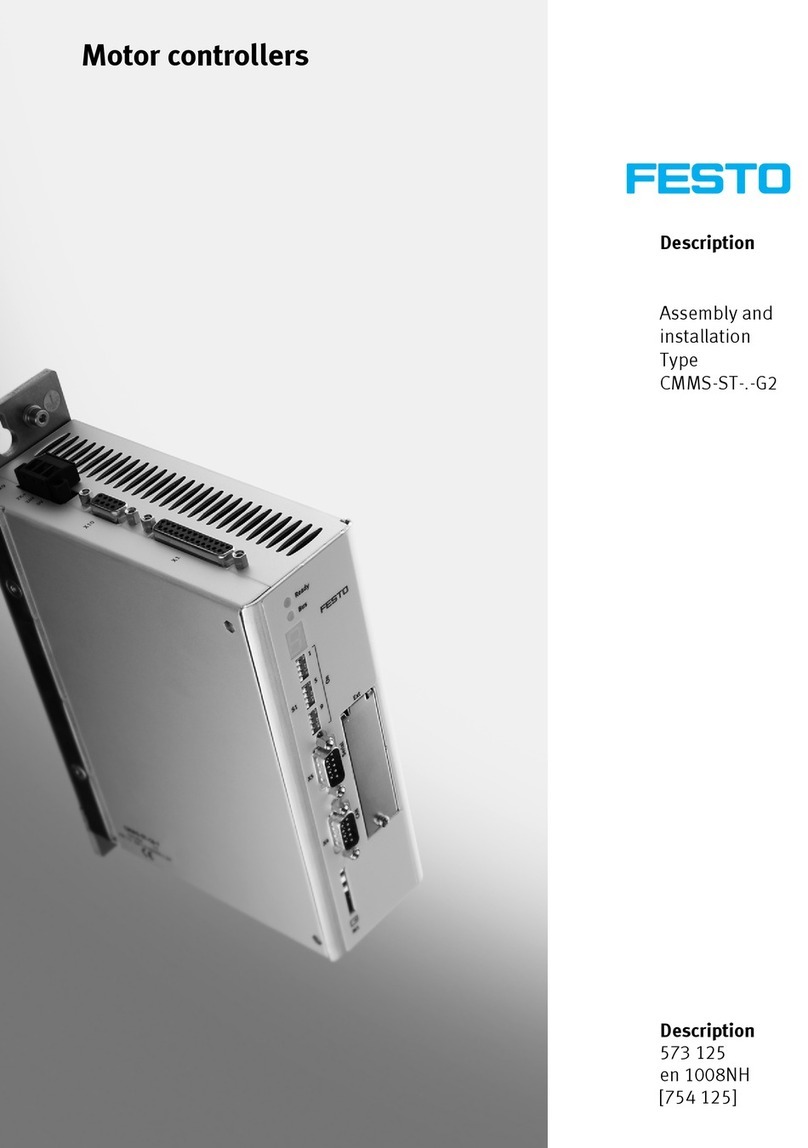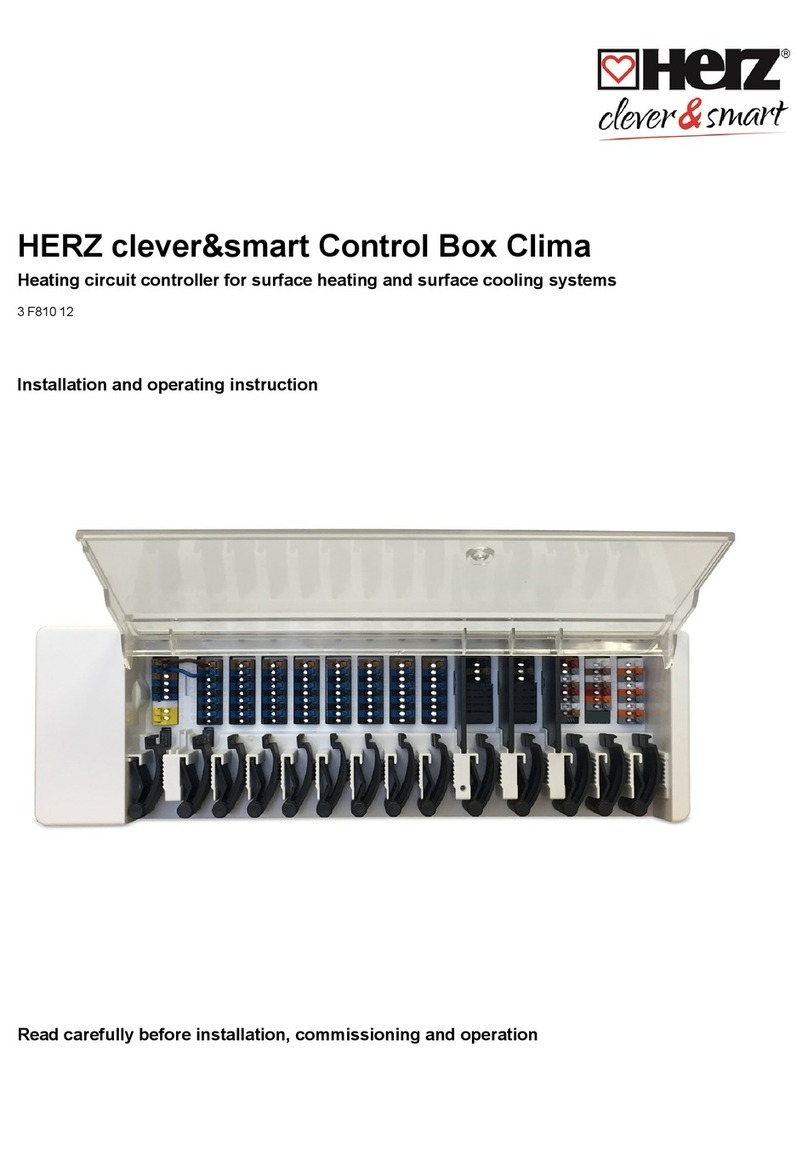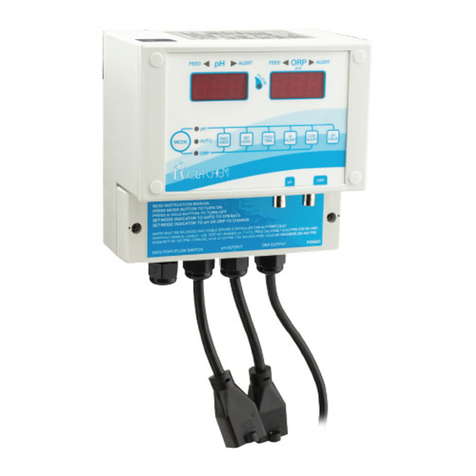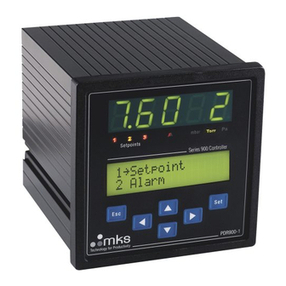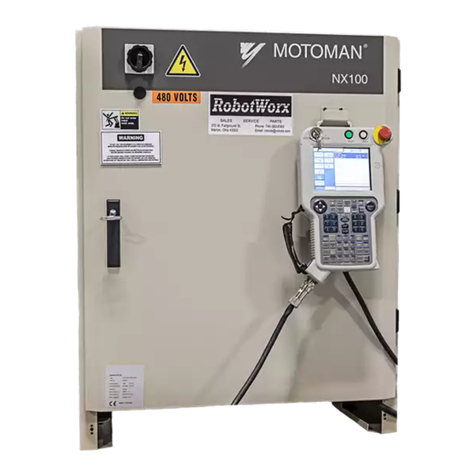AUMA NORM SQ 05.2 Administrator Guide

Part-turn actuators
SQ 05.2 –SQ 14.2/SQR 05.2 –SQR 14.2
AUMA NORM (without controls)
Assembly, operation, commissioningOperation instructions

Read operation instructions first.
●Observe safety instructions.
●These operation instructions are part of the product.
●Retain operation instructions during product life.
●Pass on instructions to any subsequent user or owner of the product.
Purpose of the document:
This document contains information for installation, commissioning, operation and maintenance staff.It is intended
to support device installation and commissioning.
Table of contents Page
41. Safety instructions................................................................................................................. 41.1. Basic information on safety 41.2. Range of application 51.3. Applications in Ex zone 22 (option) 51.4. Warnings and notes 61.5. References and symbols
72. Identification........................................................................................................................... 72.1. Name plate 82.2. Short description
93. Transport, storage and packaging........................................................................................ 93.1. Transport 93.2. Storage 93.3. Packaging
104. Assembly................................................................................................................................ 104.1. Mounting position 104.2. Handwheel fitting 104.3. Actuator: mount to valve 114.3.1. Valve attachment via coupling
135. Electrical connection............................................................................................................. 135.1. Basic information 145.2. Connection with AUMA plug/socket connector 145.2.1. Terminal compartment: open 155.2.2. Cable connection 175.2.3. Terminal compartment: close 175.3. Accessories for electrical connection 175.3.1. Parking frame 185.3.2. Protection cover 185.3.3. Double sealed intermediate frame 185.3.4. Earth connection, external
196. Operation................................................................................................................................ 196.1. Manual operation 196.1.1. Manual operation: engage 196.1.2. Manual operation: disengage 196.2. Motor operation
2
SQ 05.2 –SQ 14.2/SQR 05.2 –SQR 14.2
Table of contents

207. Indications.............................................................................................................................. 207.1. Mechanical position indicator/running indication
218. Signals..................................................................................................................................... 218.1. Feedback signals from actuator
229. Commissioning...................................................................................................................... 229.1. End stops in part-turn actuator 239.1.1. End stop CLOSED: set 239.1.2. End stop OPEN: set 239.2. Switch compartment: open 249.3. Torque switching: set 259.4. Limit switching: set 259.4.1. End position CLOSED (black section): set 259.4.2. End position OPEN (white section): set 269.5. Intermediate positions: set 269.5.1. Running direction CLOSE (black section): set 279.5.2. Running direction OPEN (white section): set 279.6. Test run 279.6.1. Direction of rotation: check 279.6.2. Limit switching: check 289.7. Electronic position transmitter EWG 01.1 299.7.1. Measuring range: set 309.7.2. Current values: adjust 309.7.3. LED end position signalling: switch on/off 309.8. Potentiometer 319.8.1. Potentiometer setting 319.9. Electronic position transmitter RWG 329.9.1. Measuring range: set 329.10. Mechanical position indicator: set 339.11. Switch compartment: close
3410. Corrective action.................................................................................................................... 3410.1. Faults during commissioning 3410.2. Motor protection (thermal monitoring)
3611. Servicing and maintenance................................................................................................... 3611.1. Preventive measures for servicing and safe operation 3611.2. Maintenance 3611.3. Disposal and recycling
3812. Technical data......................................................................................................................... 3812.1. Technical data Part-turn actuator
4113. Spare parts............................................................................................................................. 4113.1. Part-turn actuators SQ 05.2 –SQ 14.2/SQR 05.2 –SQR 14.2
4314. Certificates.............................................................................................................................. 4314.1. Declaration of Incorporation and EC Declaration of Conformity
44Index........................................................................................................................................
46Addresses...............................................................................................................................
3
SQ 05.2 –SQ 14.2/SQR 05.2 –SQR 14.2 Table of contents

1. Safety instructions
1.1. Basic information on safety
Standards/directives AUMA products are designed and manufactured in compliance with recognised
standards and directives.This is certified in a Declaration of Incorporation and an
EC Declaration of Conformity.
The end user or the contractor must ensure that all legal requirements, directives,
guidelines, national regulations and recommendations with respect to assembly,
electrical connection, commissioning and operation are met at the place of installation.
Safetyinstructions/warn-
ings All personnel working with this device must be familiar with the safety and warning
instructions in this manual and observe the instructions given. Safety instructions
and warning signs on the device must be observed to avoid personal injury or property
damage.
Qualification of staff Assembly, electrical connection, commissioning, operation, and maintenance must
be carried out exclusively by suitably qualified personnel having been authorised by
the end user or contractor of the plant only.
Prior to working on this product, the staff must have thoroughly read and understood
these instructions and, furthermore, know and observe officially recognised rules
regarding occupational health and safety.
Commissioning Prior to commissioning, it is important to check that all settings meet the requirements
of the application. Incorrect settings might present a danger to the application, e.g.
cause damage to the valve or the installation.The manufacturer will not be held
liable for any consequential damage.Such risk lies entirely with the user.
Operation Prerequisites for safe and smooth operation:
●Correct transport, proper storage, mounting and installation, as well as careful
commissioning.
●Only operate the device if it is in perfect condition while observing these instruc-
tions.
●Immediately report any faults and damage and allow for corrective measures.
●Observe recognised rules for occupational health and safety.
●Observe the national regulations.
●During operation,thehousingwarmsupandsurface temperatures > 60 °Cmay
occur.To prevent possible burns, we recommend checking the surface temper-
ature using an appropriate thermometer and wearing protective gloves, if re-
quired, prior to working on the device.
Protective measures The end user or the contractor are responsible for implementing required protective
measures on site, such as enclosures, barriers, or personal protective equipment
for the staff.
Maintenance To ensure safe device operation, the maintenance instructions included in this manual
must be observed.
Any device modification requires prior consent of the manufacturer.
1.2. Range of application
AUMA part-turn actuators are designed for the operation of industrial valves, e.g.
butterfly valves and ball valves.
Other applications require explicit (written) confirmation by the manufacturer.
The following applications are not permitted, e.g.:
●Industrial trucks according to EN ISO 3691
●Lifting appliances according to EN 14502
●Passenger lifts according to DIN 15306 and 15309
●Service lifts according to EN 81-1/A1
4
SQ 05.2 –SQ 14.2/SQR 05.2 –SQR 14.2
Safety instructions

●Escalators
●Continuous duty
●Buried service
●Permanent submersion (observe enclosure protection)
●Potentially explosive areas, with the exception of zone 22
●Radiation exposed areas in nuclear power plants
No liability can be assumed for inappropriate or unintended use.
Observance of these operation instructions is considered as part of the device's
designated use.
Information These operation instructions are only valid for the "clockwise closing" standard
version, i.e. driven shaft turns clockwise to close the valve.
1.3. Applications in Ex zone 22 (option)
Actuators of the indicated series basically meet the requirements for applications in
dust hazardous locations of ZONE 22 in compliance with the ATEX directive 94/9/EC.
The actuators are designed to meet enclosure protection IP68 and fulfil the
requirements of EN 50281-1-1:1998 section 6 - Electrical apparatus for use in
presence of combustible dust, requirements for category 3 electrical equipment -
protected by enclosures.
To comply with all requirements of EN 50281-1-1:1998, it is imperative that the
following points are observed:
●IncompliancewiththeATEXdirective94/9/EC,theactuatorsmustbe equipped
with an additional identification –II3D IP6X T150 °C.
●The maximum surface temperature of the actuators, based on an ambient
temperature of +40 °C in accordance with EN 50281-1-1 section 10.4, is +150
°C.In accordance with section 10.4, an increased dust deposit on the equipment
was not considered for the determination of the maximum surface temperature.
●The correct connection of the thermoswitches or the PTC thermistors as well
as fulfilling the requirements of the duty type and the technical data are pre-
requisites for compliance with the maximum surface temperature of devices.
●The connection plug may only be plugged in or pulled out when device is dis-
connected from the mains.
●The cable glands used also have to meet the requirements of category II3 D
and must at least comply with enclosure protection IP68.
●The actuators must be connected by means of an external ground connection
(accessory part) to the potential compensation or integrated into an earthed
piping system.
●As a general rule, the requirements of EN 50281-1-1 must be respected in dust
hazardous locations.During commissioning, service, and maintenance, special
care as well as qualified and trained personnel are required for the safe operation
of actuators.
1.4. Warnings and notes
The following warnings draw special attention to safety-relevant procedures in these
operation instructions, each marked by the appropriate signal word (DANGER,
WARNING, CAUTION, NOTICE).
Indicates an imminently hazardous situation with a high level of risk. Failure
to observe this warning could result in death or serious injury.
Indicates a potentially hazardous situation with a medium level of risk. Failure
to observe this warning could result in death or serious injury.
5
SQ 05.2 –SQ 14.2/SQR 05.2 –SQR 14.2 Safety instructions

Indicates a potentially hazardous situation with a low level of risk. Failure to
observe this warning may result in minor or moderate injury. May also be used
with property damage.
Potentially hazardous situation. Failure to observe this warning may result in
property damage. Is not used for personal injury.
Arrangement and typographic structure of the warnings
Type of hazard and respective source!
Potential consequence(s) in case of non-observance (option)
→Measures to avoid the danger
→Further measure(s)
Safety alert symbol warns of a potential personal injury hazard.
The signal word (here: DANGER) indicates the level of hazard.
1.5. References and symbols
The following references and symbols are used in these instructions:
Information The term Information preceding the text indicates important notes and information.
Symbol for CLOSED (valve closed)
Symbol for OPEN (valve open)
Important information before the next step.This symbol indicates what is required
for the next step or what has to be prepared or observed.
< > Reference to other sections
Terms in brackets shown above refer to other sections of the document which provide
further information on this topic.These terms are either listed in the index, a heading
or in the table of contents and may quickly be found.
6
SQ 05.2 –SQ 14.2/SQR 05.2 –SQR 14.2
Safety instructions

2. Identification
2.1. Name plate
Each device component (actuator, motor) is equipped with a name plate.
Figure 1: Arrangement of name plates
[1] Motor name plate
[2] Actuator name plate
[3] Additional plate, e.g. KKS plate (Power Plant Classification System)
Description of actuator name plate
Figure 2: Actuator name plate (example)
[1] Name of manufacturer
[2] Address of manufacturer
[3] Type designation
[4] Order number
[5] Actuator serial number
[6] Operating time in [s] for a part-turn movement of 90°
[7] Torque range in direction CLOSE
[8] Torque range in direction OPEN
[9] Type of lubricant
[10] Enclosure protection
[11] Permissible ambient temperature
[12] Can be assigned as an option upon customer request
[13] Can be assigned as an option upon customer request
[14] Data Matrix code
7
SQ 05.2 –SQ 14.2/SQR 05.2 –SQR 14.2 Identification

Type designation Figure 3:Type designation (example)
1. Type and size of actuator
2. Flange size
Type and size
These instructions apply to the following devices types and sizes:
Part-turn actuators for open-close duty: SQ 05.2, 07.2, 10.2, 12.2, 14.2
Part-turn actuators for modulating duty: SQR05.2, 07.2, 10.2, 12.2, 14.2
Order number The product can be identified using this number and the technical data as well as
order-related data pertaining to the device can be compiled.
Please always state this number for any product inquiries.
On the Internet at http://www.auma.com, we offer a service allowing authorised
users to download order-related documents such as wiring diagrams and technical
data (both in German and English), inspection certificates and the operation
instructions when entering the order number.
Actuator serial number Table 1: Description of serial number (with example)
NS123451405
1st + 2nd position: Assembly in week
Week 0505
3rd + 4th position:Year of manufacture
Year of manufacture:201414
All other positions Internal number for unambiguous product identificationNS12345
Data Matrix code When registered as authorised user, you may use the AUMA Support App to scan
the Data Matrix code and directly access the order-related product documents without
having to enter order number of serial number.
Figure 4: Link to the App store:
2.2. Short description
Part-turn actuator Definition in compliance with EN ISO 5211:
A part-turn actuator is an actuator which transmits a torque to the valve for less than
one full revolution.It need not be capable of withstanding thrust.
AUMA part-turn actuators are driven by an electric motor. A handwheel is provided
for manual operation.Switching off in end positions may be either by limit or torque
seating. Controls are required to operate or process the actuator signals.
Actuators without controls can be equipped with AUMA actuator controls at a later
date.For more information, please state our order number (refer to actuator name
plate).
8
SQ 05.2 –SQ 14.2/SQR 05.2 –SQR 14.2
Identification

3. Transport, storage and packaging
3.1. Transport
For transport to place of installation, use sturdy packaging.
Hovering load!
Risk of death or serious injury.
→Do NOT stand below hovering load.
→Attach ropes or hooks for the purpose of lifting by hoist only to housing and NOT
to handwheel.
→Actuators mounted on valves: Attach ropes or hooks for the purpose of lifting
by hoist to valve and NOT to actuator.
→Actuatorsmountedtogearboxes:Attach ropesorhooksfor the purpose of lifting
by hoist only to the gearbox using eyebolts and NOT to the actuator.
→Actuators mounted to controls: Attach ropes or hooks for the purpose of lifting
by hoist only to the actuator and NOT to the controls.
3.2. Storage
Danger of corrosion due to inappropriate storage!
→Store in a well-ventilated, dry room.
→Protect against floor dampness by storage on a shelf or on a wooden pallet.
→Cover to protect against dust and dirt.
→Apply suitable corrosion protection agent to uncoated surfaces.
Long-term storage If the device must be stored for a long period (more than 6 months) the following
points must be observed in addition:
1. Prior to storage:
Protect uncoated surfaces, in particular the output drive parts and mounting
surface, with long-term corrosion protection agent.
2. At an interval of approx. 6 months:
Check for corrosion.If first signs of corrosion show, apply new corrosion protec-
tion.
3.3. Packaging
Our products are protected by special packaging for transport when leaving the
factory.The packaging consists of environmentally friendly materials which can easily
be separated and recycled.We use the following packaging materials: wood,
cardboard, paper, and PE foil.For the disposal of the packaging material, we
recommend recycling and collection centres.
9
SQ 05.2 –SQ 14.2/SQR 05.2 –SQR 14.2 Transport, storage and packaging

4. Assembly
4.1. Mounting position
AUMA actuators can be operated without restriction in any mounting position.
4.2. Handwheel fitting
Figure 5: Handwheel
[1] Spacer
[2] Input shaft
[3] Handwheel
[4] Circlip
1. If required, fit spacer [1] onto input shaft [2].
2. Slip handwheel [3] onto input shaft.
3. Secure handwheel [3] using the circlip [4] supplied.
4.3. Actuator: mount to valve
Danger of corrosion due to damage to paint finish and condensation!
→Touch up damage to paint finish after work on the device.
→After mounting, connect the device immediately to electrical mains to ensure
that heater minimises condensation.
The actuator is mounted to the valve using a coupling (standard) or via lever.Separate
instructions are available for actuator mounting to the valve when equipped with
base and lever.
10
SQ 05.2 –SQ 14.2/SQR 05.2 –SQR 14.2
Assembly

4.3.1. Valve attachment via coupling
Dimensions Figure 6: Coupling fitting dimensions
[1] Coupling
[2] Valve shaft
[3] Grub screw
[4] Screw
Table 2: Coupling fitting dimensions
Z max [mm]Y max [mm]X max [mm]Type, size - output mounting flange 4023SQ/SQR 05.2-F05/F07 4023SQ/SQR 07.2-F05/F07 6623SQ/SQR 07.2-F10 5054SQ/SQR 10.2-F10 8254SQ/SQR 10.2-F12 61105SQ/SQR 12.2-F12 101105SQ/SQR 12.2-F14 75108SQ/SQR 14.2-F14 125108SQ/SQR 14.2-F16
Assembly Information: Mount valve and actuator in the same end position.
- For butterfly valves: Recommended mounting position is end position
CLOSED.
- For ball valves: Recommended mounting position is end position OPEN.
1. Thoroughly degrease mounting faces of output mounting flanges.
2. Apply a small quantity of grease to the valve shaft [2].
3. Use handwheel to run actuator to mechanical end stop.
4. Place coupling [1] onto valve shaft [2] and secure against axial slipping by using
a grub screw, a circlip or a screw.Thereby, ensure that dimensions X,Y or Z
are observed (refer to figure and table <Coupling fitting dimensions>).
5. Apply non-acidic grease at splines of coupling.
6. Fit actuator.
Information: Ensure that the spigot (if provided) fits uniformly in the recess
and that the flanges are in complete contact.
7. If flange bores do not match thread:
7.1 Slightly rotate handwheel until bores line up.
7.2 If required, shift actuator position by one tooth on the coupling.
11
SQ 05.2 –SQ 14.2/SQR 05.2 –SQR 14.2 Assembly

8. Fasten actuator with screws [4].
Information: We recommend applying liquid thread sealing material to the
screws to avoid contact corrosion.
→Fasten screws [4] crosswise with a torque according to table.
Table 3:Tightening torques for screws
Tightening torqueTA[Nm]Screws
Threads Strength class 8.8
11M6 25M8 51M10 87M12 214M16
12
SQ 05.2 –SQ 14.2/SQR 05.2 –SQR 14.2
Assembly

5. Electrical connection
5.1. Basic information
Danger due to incorrect electrical connection
Failure to observe this warning can result in death, serious injury, or property damage.
→The electrical connection must be carried out exclusively by suitably qualified
personnel.
→Prior to connection, observe basic information contained in this chapter.
→After connection but prior to applying the voltage, observe the <Commissioning>
and <Test run> chapters.
Wiring diagram/terminal
plan The pertaining wiring diagram/terminal plan (both in German and English) is attached
to the device in a weather-proof bag, together with these operation instructions.It
can also be requested from AUMA (state order number, refer to name plate) or
downloaded directly from the Internet (http://www.auma.com).
Valve damage for connection without controls!
→NORM actuators require controls: Connect motor via controls only (reversing
contactor circuit).
→Observe the type of seating specified by the valve manufacturer.
→Observe wiring diagram.
Delay time Thedelaytime isthe time from the tripping of the limit or torque switchestothemotor
power being switched off.To protect the valve and the actuator, we recommend a
delay time < 50 ms.Longer delay times are possible provided the operating time,
output drive type, valve type, and the type of installation are considered.We
recommend switching off the corresponding contactor directly by limit or torque
switch.
Protection on site For short-circuit protection and for disconnecting the actuator from the mains, fuses
and disconnect switches have to be provided by the customer.
The current value for respective sizing is derived from the current consumption of
the motor (refer to electrical data sheet).
Limit and torque
switches Limit and torque switches can be provided as single, tandem, or triple switches.Only
the same potential can be switched on the two circuits (NC/NO contact) of each
single switch. If different potentials are to be switched simultaneously, tandem
switches or triple switches are required.When using tandem/triple switches:
●For signalling use the leading contacts TSC1, TSO1, LSC1, LSO1.
●For switching off use the lagging contacts TSC, TSO, LSC, LSO.
Type of current, mains
voltage and mains fre-
quency
Type of current, mains voltage and mains frequency must match the data on the
motor name plate.
13
SQ 05.2 –SQ 14.2/SQR 05.2 –SQR 14.2 Electrical connection

Figure 7: Motor name plate (example)
[1] Type of current
[2] Mains voltage
[3] Mains frequency (for 3-ph and 1-ph AC motors)
Connecting cables ●For device insulation, appropriate (voltage-proof) cables must be used.Specify
cables for the highest occurring rated voltage.
●Use connecting cable with appropriate minimum rated temperature.
●For connecting cables exposed to UV radiation (outdoor installation), use UV
resistant cables.
5.2. Connection with AUMA plug/socket connector
Cross sections AUMA plug/socket connector:
●Power terminals (U1, V1, W1, U2, V2, W2):max. 6 mm² flexible/10 mm² solid
●PE connection : max. 6 mm² flexible/10 mm² solid
●Control contacts (1 to 50): max. 2.5 mm²
5.2.1. Terminal compartment: open
Figure 8: Connection AUMA plug/socket connector, version S
[1] Cover
[2] Screws for cover
[3] O-ring
[4] Screws for socket carrier
[5] Socket carrier
[6] Cable entry
[7] Blanking plug
[8] Cable gland (not included in delivery)
14
SQ 05.2 –SQ 14.2/SQR 05.2 –SQR 14.2
Electrical connection

Hazardous voltage!
Risk of electric shock.
→Disconnect device from the mains before opening.
1. Loosen screws [2] and remove cover [1].
2. Loosen screws [4] and remove socket carrier [5] from cover [1].
3. Insert cable glands [8] suitable for connecting cables.
➥The enclosure protection IP...stated on the name plate is only ensured if suitable
cable glands are used.
Figure 9: Example: Name plate shows enclosure protection IP68
4. Seal unused cable entries [6] with suitable blanking plugs [7].
5. Insert the cables into the cable glands [8].
5.2.2. Cable connection
✔Observe permissible cross sections.
Danger of motor damage if PTC thermistors or thermoswitches are not con-
nected!
Our warranty for the motor will lapse if the motor protection is not connected.
→Connect PTC thermistors or thermoswitches to external controls.
Danger of corrosion: Damage due to condensation!
→After mounting, commission the device immediately to ensure that heater min-
imises condensation.
1. Remove cable sheathing.
2. Strip wires.
3. For flexible cables:Use end sleeves according to DIN 46228.
4. Connect cables according to order-related wiring diagram.
15
SQ 05.2 –SQ 14.2/SQR 05.2 –SQR 14.2 Electrical connection

In case of a fault: Hazardous voltage while protective earth conductor is NOT
connected!
Risk of electric shock.
→Connect all protective earth conductors.
→Connect PE connection to external protective earth conductor of connecting
cables.
→Start running the device only after having connected the protective earth con-
ductor.
5. Tighten PE conductors firmly to PE connection using ring lugs (flexible cables)
or loops (rigid cables).
Figure 10: PE connection
[1] Socket carrier
[2] Screw
[3] Washer
[4] Lock washer
[5] Protective earth with ring lugs/loops
[6] PE connection, symbol:
Information Some actuators are equipped with an additional motor heater.The motor heater
minimises condensation within the motor.
16
SQ 05.2 –SQ 14.2/SQR 05.2 –SQR 14.2
Electrical connection

5.2.3. Terminal compartment: close
Figure 11: Example:Version S
[1] Cover
[2] Screws for cover
[3] O-ring
[4] Screws for socket carrier
[5] Socket carrier
[6] Cable entry
[7] Blanking plug
[8] Cable gland (not included in delivery)
Short-circuit due to pinching of cables!
Risk of electric shock and functional failures.
→Carefully fit socket carrier to avoid pinching the cables.
1. Insert the socket carrier [5] into the cover [1] and fasten with screws [4].
2. Clean sealing faces of cover [1] and housing.
3. Check whether O-ring [3] is in good condition, replace if damaged.
4. Apply a thin film of non-acidic grease (e.g.petroleum jelly) to the O-ring and
insert it correctly.
5. Fit cover [1] and fasten screws [2] evenly crosswise.
6. Fasten cable glands [8] applying the specified torque to ensure the required
enclosure protection.
5.3. Accessories for electrical connection
—Option —
5.3.1. Parking frame
Application Parking frame for safe storage of a disconnected plug.
For protection against touching the bare contacts and against environmental
influences.
17
SQ 05.2 –SQ 14.2/SQR 05.2 –SQR 14.2 Electrical connection

Figure 12: Parking frame
5.3.2. Protection cover
Protection cover for plug compartment when plug is removed.
The open terminal compartment can be closed using a protective cover (not
illustrated).
5.3.3. Double sealed intermediate frame
When removing the electrical connection or due to leaky cable glands, ingress of
dust and water into the housing may occur.This is prevented effectively by inserting
the double sealed intermediate frame [2] between the plug/socket connector [1] and
the housing of the device.The enclosure protection of the device (IP68) will not be
affected, even if the electrical connection [1] is removed.
Figure 13: Electrical connection with double sealed intermediate frame
[1] Electrical connection
[2] Double sealed intermediate frame
[3] Actuator housing
5.3.4. Earth connection, external
As an option, the housing is equipped with an external earth connection (U-bracket)
to connect the device to the equipotential earth bonding.
Figure 14: Earth connection
18
SQ 05.2 –SQ 14.2/SQR 05.2 –SQR 14.2
Electrical connection

6. Operation
6.1. Manual operation
For purposes of setting and commissioning, in case of motor or power failure, the
actuator may be operated manually. Manual operation is engaged by an internal
change-over mechanism.
6.1.1. Manual operation: engage
Damage at the motor coupling due to faulty operation!
→Engage manual operation only during motor standstill.
1. Press push button.
2. Turn handwheel in desired direction.
→To close the valve, turn handwheel clockwise:
➥Drive shaft (valve) turns clockwise in direction CLOSE.
6.1.2. Manual operation: disengage
Manual operation is automatically disengaged when motor is started again.The
handwheel does not rotate during motor operation.
6.2. Motor operation
Valve damage due to incorrect setting!
→Perform all commissioning settings and the test run prior to motor operation.
Controls are required to operate an actuator during motor operation. If the actuator
is to be operated locally, additional local controls are required.
1. Switch on power supply.
2. To close the valve, switch on motor operation in direction CLOSE.
➥Valve shaft turns clockwise in direction CLOSE.
19
SQ 05.2 –SQ 14.2/SQR 05.2 –SQR 14.2 Operation

7. Indications
7.1. Mechanical position indicator/running indication
Mechanical position indicator:
●Continuously indicates the valve position
(For a swing angle of 90°, the indicator disc [2] rotates by approximately 180°.)
●Indicates whether the actuator is running (running indication)
●Indicates that the end positions are reached (via indicator mark [3])
Figure 15: Mechanical position indicator
[1] Cover
[2] Indicator disc
[3] Mark
[4] Symbol for position OPEN
[5] Symbol for position CLOSED
20
SQ 05.2 –SQ 14.2/SQR 05.2 –SQR 14.2
Indications
This manual suits for next models
8
Table of contents
Other AUMA Controllers manuals
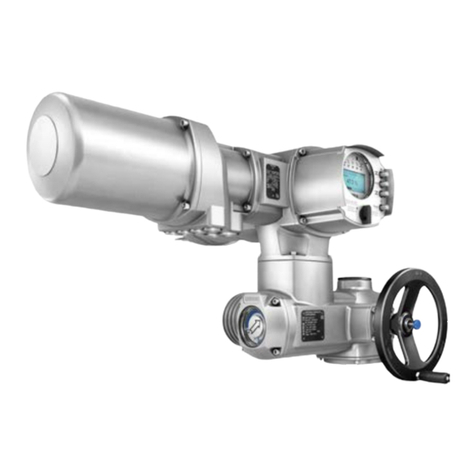
AUMA
AUMA SAV Series User manual
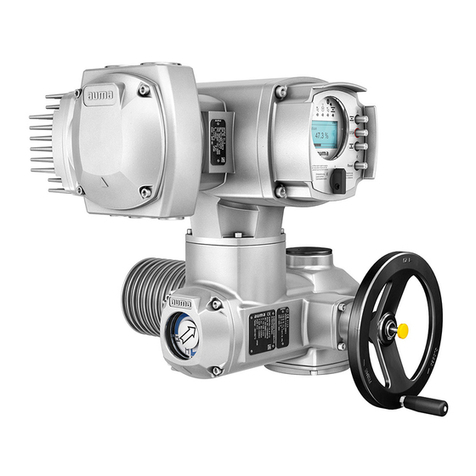
AUMA
AUMA SAVEx Series User manual
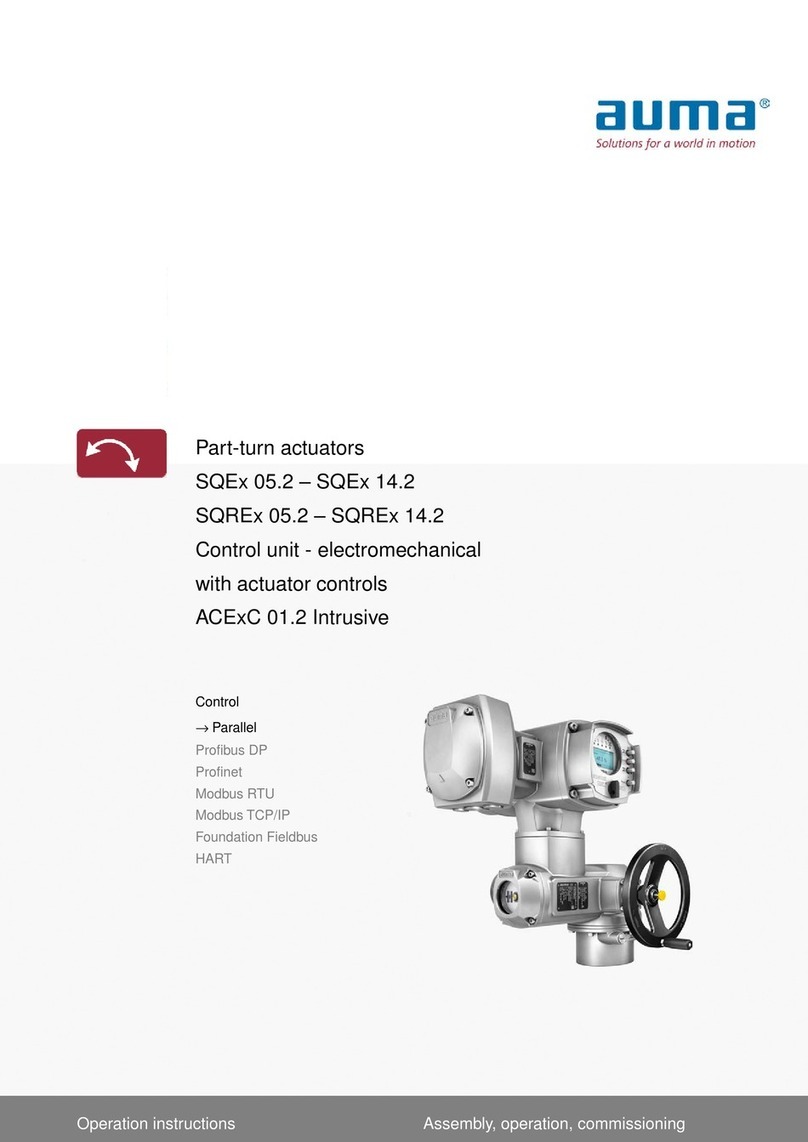
AUMA
AUMA SQEx 05.2 User manual

AUMA
AUMA SA 25.1-UW User manual
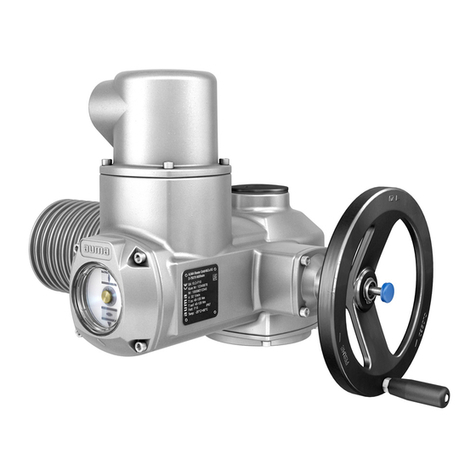
AUMA
AUMA SAE 07.2 Series Training manual

AUMA
AUMA SA-UW User manual
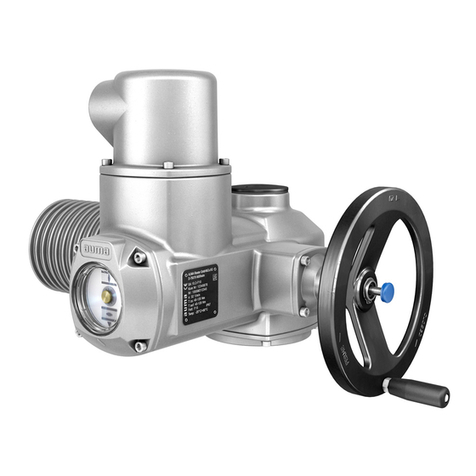
AUMA
AUMA SAM Ex 07.1 User manual
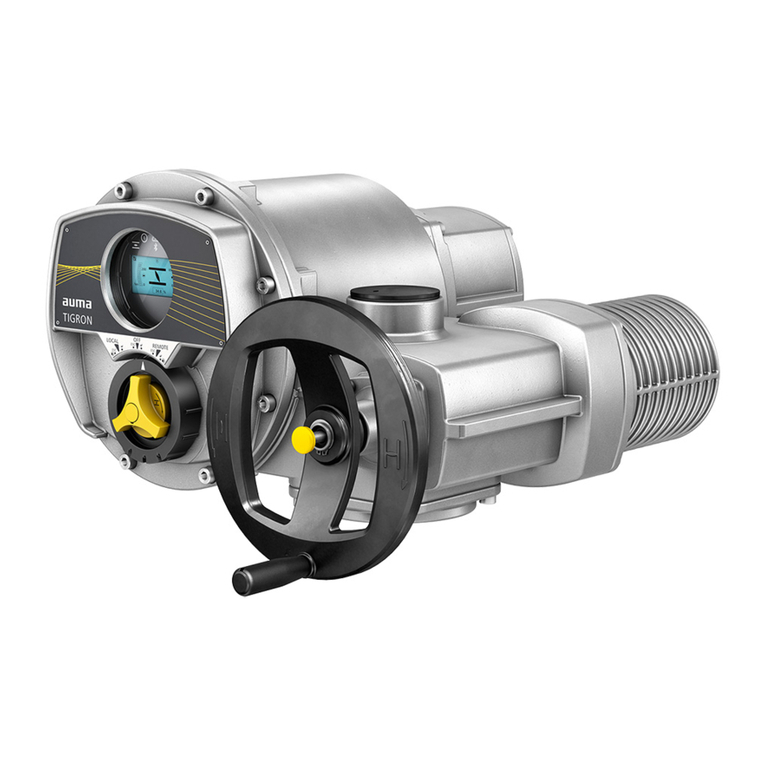
AUMA
AUMA TIGRON TR-M30X User manual
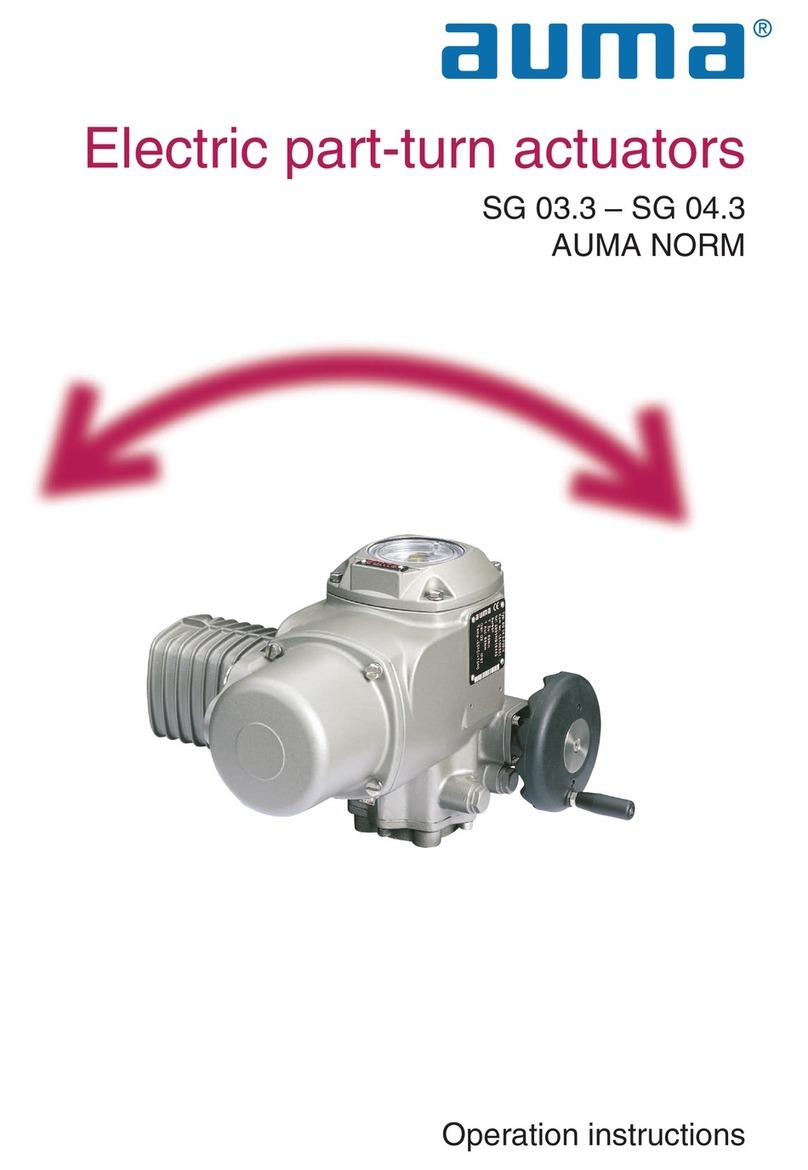
AUMA
AUMA NORM Series User manual

AUMA
AUMA TIGRON TR-M30X Manual
Popular Controllers manuals by other brands
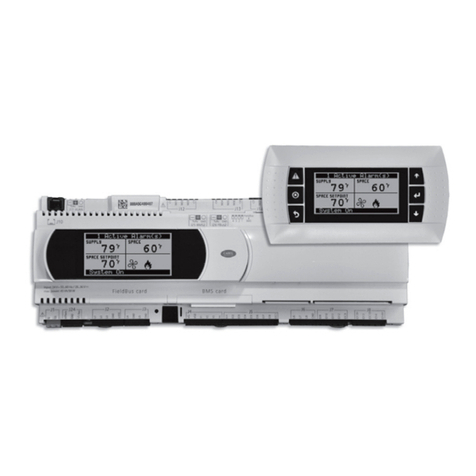
Greenheck
Greenheck DOAS v8.1 reference guide
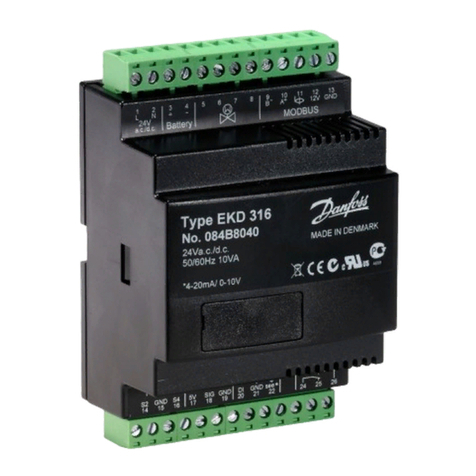
Danfoss
Danfoss EKD 316C Colibri installation guide
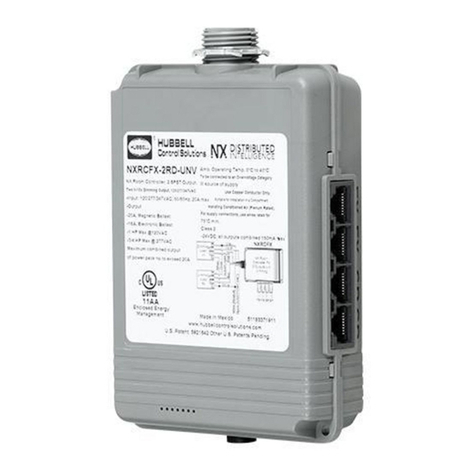
Hubbell
Hubbell NX Distributed Intelligence NXRCFX Series installation instructions
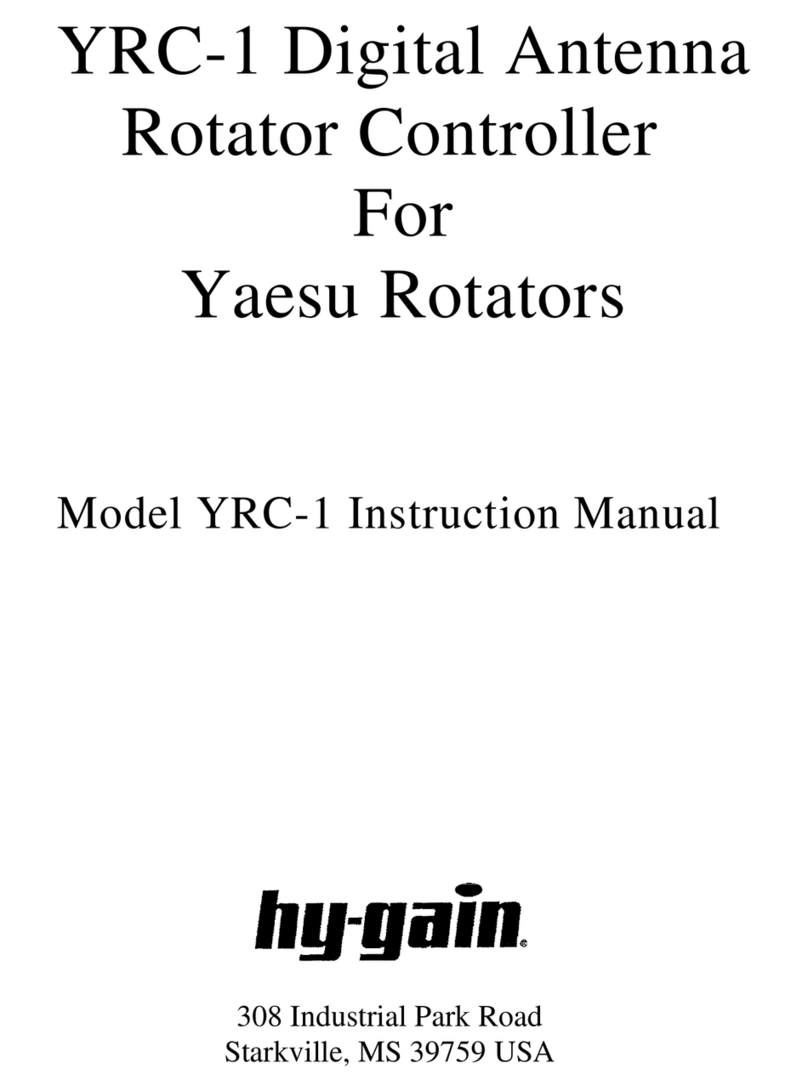
Hy-Gain
Hy-Gain YRC-1 instruction manual
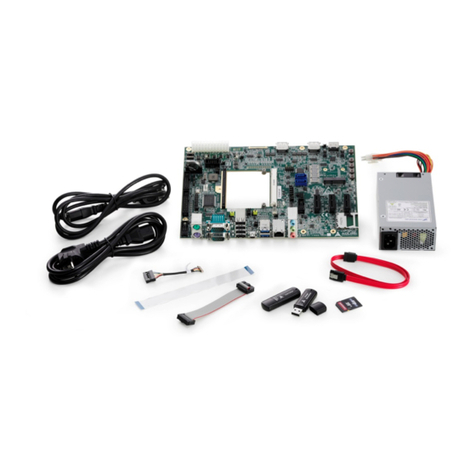
ADLINK Technology
ADLINK Technology Qseven quick start guide
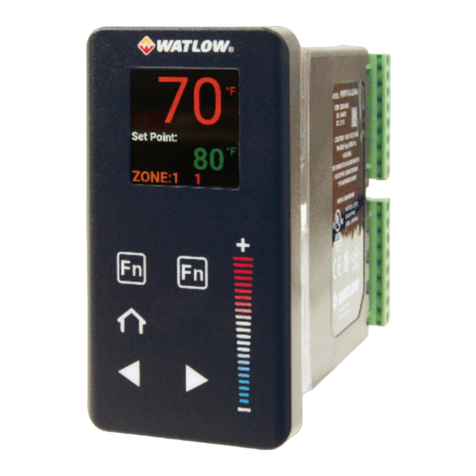
Watlow
Watlow PM PLUS quick start guide
